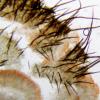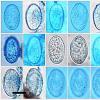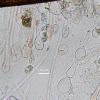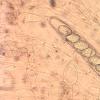
01-01-2026 18:35
Original loamy soil aside a artificial lake.The co

31-12-2025 19:27
Collected from loamy soil, at waterside (completel

30-12-2025 16:44
Pascal DucosBonjour,Une anamorphe rose stipitÊe, très nombre

30-12-2025 17:14
 Bernard CLESSE
Bernard CLESSE
Bonjour Ă toutes et tous,Pourriez-vous aider Albe

29-12-2025 10:15
Hulda Caroline HolteHello, I found and collected this propoloid ascom

30-12-2025 09:04
Hello.A Pyrenomycete sprouting sparsely but very d

29-12-2025 17:44
Isabelle CharissouBonjour,J'aimerais savoir si d'autres personnes au
This collection of Scutellinia were collected in Norway, on 07/28/17, on bark of a branch, probably of birch, semisumergida in a stream. The apothecia measures 3-8 mm.
Ellipsoidal ascospores with verrucous decoration very little visible in the spore contour, without forming crests and of length< 5 ¾m
(18.5) 20.3 - 23.5 (24.9) Ă (11.2) 11.9 - 13.6 (14.5)Â Âľm
Q = (1.5) 1.6 - 1.8 (2); N = 25
Me = 21.7 Ă 12.6 Âľm; Qe = 1.7
Ascas inamiloidesÂ
(234.3) 237.3 - 298.1 (308) Ă (14.7) 15.2 - 20.3 (23) Âľm
Hairs of the margin quite long and with the pale apex and frequently bifurcated base, of
(289.1) 387.3 - 1394.2 (1531.1) x (17.7) 23.8 - 32.3 (33.8)Â Âľm
Much shorter external face hairs
Often bifurcated at the base (226.4) 229.8 - 272 (276.5) Ă (6.8) 9 - 10.9 (12.1)Â Âľm

I'm not sure, if all the measured spores are mature. Mature (ejected) spores I only saw completely filled with small lipid guttules. That two groups pattern (as in some spores in your photo, e.g. bottom left corner) I saw only when they were still in ascus.Â
I would exclude subhirtella, the hairs are about twice so long here. It is probably something from the long-haired group S. crinita, S. scutellata and S. pilati, I think the hair base is wide and short with many roots, the roots sometimes branching.
If the ornamentation is visible on the spore outline with 40x objective, it should exclude S. pilati (which has only up to 0,3-0,4 um high ornamentation, visible on the outline only with immersion). If you don't have sporeprint, you can try to make a preparate from a little piece from the middle of the hymenium - the spores should be most mature there. I wouldn't be surprised if it's S. crinita.Â
Viktorie
Measures of ascospores are taken on those that were expelled from the ascas, and only the second spore above contained lipid gut evident from all spores measured, I suppose because it was immature and had not yet developed sporal ornamentation. I believe that mature spores are covered with short warts, barely visible in the contour.
The length of the hairs of the margin is (123) 230.6 - 1338.9 (1539.5) ?m
N = 60, however the mean is 561.8 ?m, and only a few of them> 800 ?m
The length of the receptacle hairs is (181.6) 189.4 - 370.9 (432.8) ?m
N = 17, and the mean of 281.3 ?m.
The root is usually bifurcated, although in the hairs of greater length is something more branched.

Mal
The spore length of my collection is more similar to S.crinita.
Mal
Ps Benats key has S crinita with a maximum spore size of 19.5 x 12

I transcribe the text of Rene's work.
Mal and Viktorie, thank you very much for your information. Greetings.
 CONTRIBUTION A L'ETUDE DES DISCOMYCETES. (1994) RenÊ Dougoud. Documents Mycologique, tome XXIV, fascicule 93. pp.9-10
"DONADINI (1980 a) dĂŠcrit pour le genre Peziza (Dill) Lin., l'aptitude des cellules de la chair et des paraphyses Ă ĂŠvoluer de la forme cylindrique Ă celle moniliforme Ă piriforme globuleuse, et il nomme fortoulisme cette ĂŠvolution (Pl. VI, fig. 4). Il distingue deux types:
a) Le fortoulisme gĂŠnotypique, caractĂŠrisĂŠ par P. varia Hedwig : Fr. et dans une moindre mesure par P. vesiculosa Bulliard :Fr., aux paraphyses peu moniliformes dans la jeunesse, mais le devenant toutes vers la maturitĂŠ, en particulier Ă la base.
b) Le fortoulisme phÊnotypique de P. nivalis (Heim & Remy) Moser et de sa variÊtÊ fortoulii (Donadini & Neville) Donadini est, pour l'essentiel, le rÊsultat de conditions Êcologiques particulières (humiditÊ très ÊlevÊe du substrat et variation de la tempÊrature)."



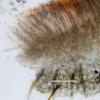
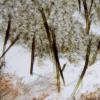
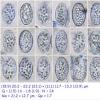
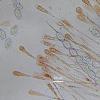
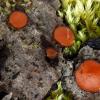
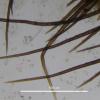
 0.MACRO.2-0001.JPG
0.MACRO.2-0001.JPG